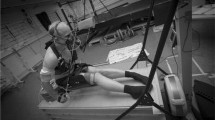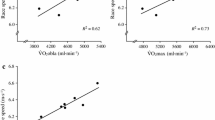Summary
Six male and six female elite speed skaters were tested during two bicycle ergometer tests: a 30 s sprint test and a 2.5 min supra maximal test. During the 2.5 min test oxygen consumption was measured every 30 s. The males showed 30–31% higher mean power output values both during the sprint test (1103 versus 769 Watt) and during the 2.5 min test (570 versus 390 Watt). Maximal oxygen consumption was 31% higher for the males than for the females (5.10 versus 3.50 l · min−1). However, when expressed per kilogram lean body weight (LBM), power output and oxygen consumption was equal for both sexes. Differences between present and previous results are most likely due to methodological problems with the estimation of load during the supra maximal test. Subjects appear to experience difficulties in distributing their power output over the 2.5 min if they are tested for the first time. For experienced skaters and cyclists, fixed levels of 19 W · kgLBM−1 as initial load setting for the sprint test and 8 W · kg LBM−1 for the 2.5 min test are recommended.
Similar content being viewed by others
References
Åstrand PO, Rodahl K (1977) Textbook of work physiology. McGraw-Hill, New York
Dill DB, Muhre LG, Greer SM, Richardson JC, Singleton KJ (1972) Body composition and aerobic capacity of youth of both sexes. Med Sci Sports 4:198–204
Dolan P, Sargeant AJ (1983) Effect of prior exercise on maximal short-term power output of human muscle. J Physiol 343:107–108
Durnin JVGA, Rahaman MM (1967) The assessment of the amount of fat in the human body from measurement of skinfold thickness. Br J Nutr 21:681–689
Geysel J, Bomhoff G, van Velsen J, de Groot G, van Ingen Schenau GJ (1984) Bicycling ergometry and speed skating performance. Int J Sports Med 5:241–245
Gollnick PD, Hermansen L (1973) Biochemical adaptions to exercise: anaerobic metabolism In: Wilmore JH (ed) Exercise and sport science Rev, vol. no. 1. Academic Press, New York, pp 1–45
Ingen Schenau GJ van, de Groot G, Hollander AP (1983) Some technical, anthropometrical and physiological aspects of speed skating. Eur J Appl Physiol 50:343–354
Ingen Schenau GJ van, de Groot G (1983a) Differences in oxygen consumption and external power between male and female skaters during supra-maximal cycling. Eur J Appl Physiol 51:337–345
Ingen Schenau GJ van, de Groot G (1983b) On the origin of differences in performance level between elite male and female speed skaters. Human Mov Sci 2:151–159
Neumann G von, Buhl H (1981) Biologische Leistungsvoraussetzungen und Trainingsphysiologische Aspekte bei trainierenden Frauen. Med Sport 21:154–160
Sparling PB (1980) A meta-analysis of studies comparing maximal oxygen uptake in men and women. Res Q 51:542–552
Author information
Authors and Affiliations
Rights and permissions
About this article
Cite this article
van Ingen Schenau, G.J., de Boer, R.W., Geysel, J.S.M. et al. Supramaximal test results of male and female speed skaters with particular reference to methodological problems. Europ. J. Appl. Physiol. 57, 6–9 (1988). https://doi.org/10.1007/BF00691230
Accepted:
Issue Date:
DOI: https://doi.org/10.1007/BF00691230




